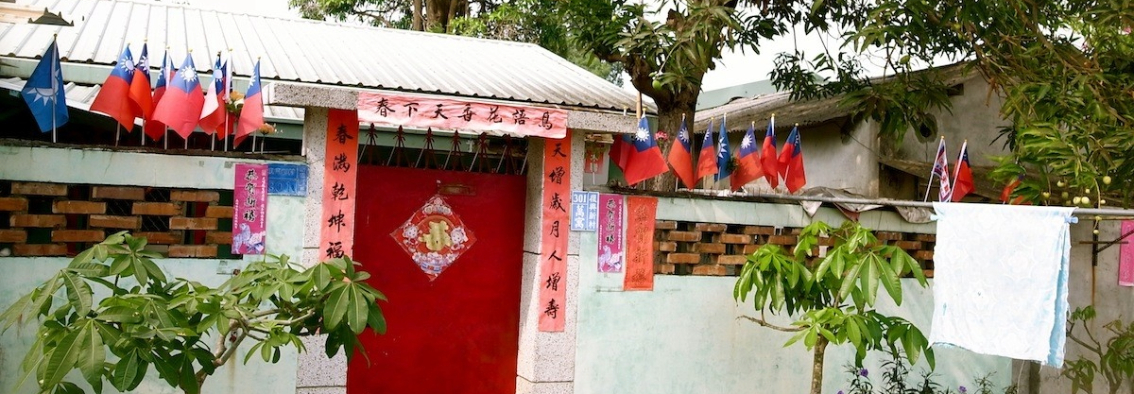When a new socialist republic was declared by Chairman Mao in 1949, many Chinese people fled to Taiwan. Dominic Yang wrote in The Great Exodus from China that this was “one of the largest and least understood instances of out-migration in twentieth-century China.” [1] The wealthiest of this population fled to the United States, but the majority ended up in Hong Kong or Taiwan. [2] In Taiwan, many of these newcomers settled in juan cun (眷村), or military dependents’ villages. Depending on their military rank, some were assigned the big houses of former Japanese military officers. Others were given simpler, one-story houses that were divided among up to eight families. [3] Regardless of how nice their assigned dwelling may have been, they all shared one thing in common: these homes were meant to be temporary settlements until the Kuomintang (KMT, 國民黨) retook China. The military villages—and Taiwan, by extension—were not meant to be a permanent home.
Over 65 years since the “great exodus,” residents of military villages and the greater Taiwanese population both need to work together to create an inclusive vision of Taiwan’s future and its national identity. As Taiwan reflects on its past as a nation, the government should ensure that the individual stories of military village residents are not lost to time. Instead, they should be included in Taiwan’s cultural memory along with the experiences of other Taiwanese people and groups.
Background
By the end of the Chinese Civil War, the mainland immigrants in Taiwan were uncertain of where to call home. Taiwan was supposed to be the temporary base for the KMT government until they retook the mainland—or at least, that was the plan. But the war was over, and the military villages that many had moved into as temporary homes had become more permanent over time. The 1.2 million Chinese newcomers were now, for better or worse, the first generation of Taiwanese mainlanders. [4] These people were called waishengren (外省人)—the “outside province people,” or simply “outsiders”—by the bendiren (本地人), or native population. Reasonably, the sense of attachment to China from these two groups differ drastically. Today, supporters of the KMT—especially those in Taiwan who identify themselves as primarily Chinese—are more likely to self-report an emotional attachment to China. The varying sense of attachment to China factors into the larger issue of Taiwanese politics and a national identity.
Air Force Village No. 2 (空軍二村)
On August 8, 2024, I met Mr. Wu Xian Hui (吳憲輝) at the Image Museum of Hsinchu City for the first time. On duty as a volunteer, he proceeded to share some photos of his childhood in Air Force Village No. 2, the military village he grew up in. Although a native Taiwanese myself, I was unfamiliar with this side of Taiwanese history, even though both Mr. Wu and I grew up in the same city of Hsinchu. Mr. Wu agreed to let me do an ethnographic report on what he had to share. Beyond my own interest, I saw value in his story as a unique and humanizing angle to approach the complicated issue of politics and identity in the early and formative stages of Taiwan’s history. In a contemporary context, I also saw value in how this story shed light on the roots of varying Taiwanese attitudes towards China today.
On April 18, 1950, Mr. Wu was born in Air Force Village No. 2 in Hsinchu, Taiwan. Mr. Wu’s father was a wartime photographer. Although the primary task of the senior Wu was to capture aerial shots of Chinese Communist Party (CCP, 中國共產黨) bases with his Yashica-D camera, he also used this camera to capture the ordinary experiences and joys of life in the military village. (Some photos are embedded in the article, but you can also see more images on my website.)
According to Yang, military villages were “residential enclaves established by the exiled KMT to house its displaced military officers and their families.” [5] Even though the tight spaces, communal living, food stamps, and war-time tension strained living conditions, Mr. Wu recalled his childhood memories fondly and he reminisced about the close-knit community that emerged as a result of these circumstances.
 Image: Mr. Wu Xianhui, his mother, and younger brother on November 18, 1960. (Image source: Photo provided by Mr. Wu.)
Image: Mr. Wu Xianhui, his mother, and younger brother on November 18, 1960. (Image source: Photo provided by Mr. Wu.)
Within Air Force Village No. 2, there were eight households in total. Thin bamboo walls divided each household to a share of 36 sq ft (6 ping). The walls were so thin that it was easy to hear noises from the other families, and Mr. Wu recalls hearing the neighbors’ mothers crying at night when news arrived from the airport of flight accidents.
The village was located next to the Air Force Academy, which Mr. Wu later attended. Alongside Air Force Village No. 1 and 3, the three villages were called xiao qian (校前), meaning “in front of the school.” Starting in 5th grade, students were expected to attend night school, a mandatory program to help students prepare for the government-issued exam before middle school. Mr. Wu recalls going home for dinner and returning to school for his night classes.
 Image: Mr. Wu’s mother made dumplings in the backyard on July 17, 1957. (Image source: Photo provided by Mr. Wu)
Image: Mr. Wu’s mother made dumplings in the backyard on July 17, 1957. (Image source: Photo provided by Mr. Wu)
A common dinner item was homemade dumplings. Mr. Wu recalls his mom making dumplings from scratch in the backyard. Dumplings were easy to make, requiring low-grade fatty pork, chives, flour, and water. Once again, you can see the bamboo walls that served as separation.
The food was cooked in a shared kitchen amongst eight households. The Da-Tong steamer was a staple that appeared in the military village kitchens and in Taiwanese kitchens to this day. Many Chinese dishes are made through the steaming process–especially rice, the most important staple in Chinese cuisine. The military residents commonly ate dishes such as fried rice with spicy Chinese sausage (香腸炒飯), fried leek dumplings (韭菜盒子), dumplings (水餃), and beef noodle soup (牛肉麵). While the food that the military residents made was Chinese in origin, the dishes also adapted through their experiences living in Taiwan. For instance, the Taiwanese rendition of the Lanzhou-style beef noodle soup evolved into a less spicy, deeper flavored dish with beef cubes instead of slices. Taiwanese beef noodle soup is now an iconic part of Taiwanese culture and is celebrated in the annual Taipei International Beef Noodle Festival, with former President Ma Ying-jeou (馬英九) recognizing Taipei as the “world capital” of this “traditional dish.”

Image: Mr. Wu’s family sharing a meal together on Chinese New Year’s Eve in 1956. (Image source: Photo provided by Mr. Wu)
Arguably the most important dinner of the entire year falls on Chinese (Lunar) New Year’s Eve. This is a time of family reunion, and the dishes are heavily symbolic to the values of Chinese culture. Pictured above is Mr. Wu’s Chinese New Year Eve dinner in 1956. You can see the large dishes in the middle of the table, laid out family style. The chicken leg is cooked whole, leaving its bones intact. This night is called tuan-yuan yei, as written in the blue text on the top left of the photo. Tuan-yuan means to come together, referencing a circle for unity. Yei means night. This picture captures a togetherness that was celebrated all over Taiwan that night.
Mr. Wu found joy in the simplicity of life, and was nostalgic for the closeness of the community he grew up in. Dinner at Air Force Village No. 2 was about community, flavors of a previous home in a new place, and settlement.
Reconstructing the Past
“All wars are fought twice, the first time on the battlefield, the second time in memory,” wrote the author Viet Thanh Nguyen. [6] Although the Chinese Civil War ended in 1949, its consequences have been long lasting. Today, the question of a Taiwanese identity is one of the most heated political discussions in Taiwan. It is also highlighted in international news media and US-Taiwan policy discussions. Considering that 67 percent of Taiwan’s population now identify primarily as Taiwanese when given the choice between Taiwanese or Chinese, it is evident that there is a growing sense of Taiwanese identity among the people of Taiwan. With each new generation born in Taiwan, Taiwanese youth become further removed from the older generations’ emotional attachment to China. In addition, growing concerns over Taiwan’s national security and cross-Strait tensions would arguably make it even harder for younger Taiwanese to understand older generations’ nostalgia.
As these stories are remembered, the war is fought for the second time—as Nguyen puts it. The effect of the past is reorganized, reassigned meaning, and we seek the answers to these questions of identity through these passed down stories. Mr. Yen, a military village inhabitant, explained that the first generation of Chinese immigrants missed their families back in China. Their children—second-generation immigrants such as himself—were nostalgic for the roots of the transplanted culture with which they grew up.
According to Yang, it is the “Taiwan-born children and grandchildren… [who] serv[e] as the curators and proponents of their parents’ and grandparents’ memories.” [7] Mr. Wu is living memory of his parents’ migration to Taiwan as he curates and proposes his father’s photographs to tell a personal, familial, and national story. Some of the military villages remain homes, while others have been transformed into memorials or weekend bazaar venues for others to be exposed to this period of history and culture. For example, the General Village (將軍村) in Hsinchu invites people to traverse the renovated village space through cafes, restaurants, and basketball courts. The village continues to create a sense of community in a modern setting.
Today, high-rise apartment complexes stand in place of the one-story houses. They are the result of government-reconstructed military villages. The apartments are redistributed based on a lottery system to former military village inhabitants. Mr. Wu laments that his previous childhood neighbors have mostly either moved away or been distributed to apartments farther away. The ren qing wei, a sense of human closeness from a tight-knit community, is lost in the renovation and revisiting of Taiwanese military villages.
How to Remember the Past
To avoid losing the history and cultural community of military villages through their reconstruction, the government should consider initiatives to preserve their memory. Rather than being torn down and transformed into generic high-rises, military villages could be designated as cultural heritage sites or adaptive reuse models (such as transforming the villages into farmer’s markets). The adaptive reuse models may follow the renovation of Songshan Cultural and Creative Park (松山文創園區) in Taipei, a former tobacco factory in the Japanese colonial period. The park celebrates the spirit of its previous factory employees while inviting people to engage in art exhibitions, performances, and markets.
Additionally, the government could transcribe the stories of the military village residents through digital archiving and oral history recordings. For example, the Hsinchu City Military Dependents’ Villages Museum (新竹市眷村博物館) displays the formation, living environment, and the atmosphere of military villages. Mr. Wu volunteers there to this day, pointing to photos he contributed to in the museum as he tells his childhood stories. Another example is the Beitou Heart Village (中心新村) in Taipei, a “museum without walls” that allows visitors to step into the preserved military village with a lived-in atmosphere. With each revisiting of military villages either through memory or in person, Taiwan’s history and identity is further explored through understanding.
The main point: Following the reconstruction of Taiwanese military villages, former village inhabitants lament a lost sense of community and cultural identity in their new apartments. As Taiwan reflects on its past as a nation and works to create an inclusive Taiwanese identity, the government should ensure that the individual stories of military village residents are not lost to time, and that they are included in Taiwan’s cultural memory—along with the experiences of other Taiwanese people and groups.
[1] Dominic Meng-Hsuan. Yang, The Great Exodus from China: Trauma, Memory, and Identity in Modern Taiwan, Cambridge: Cambridge University Press, 2020.
[2] Ibid.
[3] Ibid.
[4] Max Ko-wu Huang, “The Dilemmas of Becoming Chinese in Taiwan,” China Review 23, no. 2 (2023): 149–64, https://www.jstor.org/stable/48726995.
[5] Yang, The Great Exodus from China.
[6] Viet Thanh Nguyen, Nothing Ever Dies: Vietnam and the Memory of War, Harvard University Press, 2016, http://www.jstor.org/stable/j.ctvjk2xtq.
[7] Yang, The Great Exodus from China.



